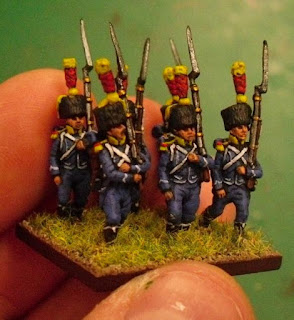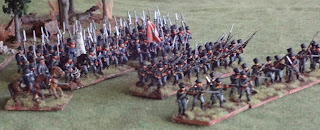It might seem like I have dropped off the face of the planet and it has felt like it at times with 2 head colds and a chest infection in 2 months (and no it wasn't just man flu Mylene!). However I have kept busy with my Prussians. I have been bashing through the figures I received from Darren (10 battalions in my sights in total, 2 complete, another just needs grass and another a slight touching up and the rest either on bases with sand added and sealed waiting to be sorted out or in the process of having additional figures painted). Still quite a long way to go, however I'm definitely getting there plus I also have the Kurassier getting their final highlights and have the lancer regiment under way as I now have new brushes. My old faithfuls were condemned after the enamel paint for the subbuteo figures.
Anyway while I get my units together Craig has sent over some more cracking pics of his late Prussian collecting with text explaining how he is bringing it all together.
Introduction
The focus of my collection since 2001 has been the 1813 Autumn campaign, and in particular the Prussian 1st Korps of GL von Yorck. I have been playing GdB since resuming wargaming, which uses a 1:20 figure ratio, and most critically (for aesthetic purposes), bases close order infantry in a double rank. Rather than just dumping a bunch of photos on Paul, I thought I would provide an explanation of my collection, as it's organisation and history have been an important and enjoyable part of it's design and construction.
IR1 1st East Prussian
The 1st Korps is structured (as were all Prussian corps at that time) as four Infantry Brigades (each equating to a Division), with a Cavalry division and Artillery support. Each Infantry Brigade is comprised of three infantry regiments, with a regiment of light cavalry, and an artillery battery in support. The Prussian army at the time had been expanded rapidly through activation of Reservists, then mobilised into reserve units, and raising of a militia – the Landwehr. In order to balance the experience of formations, each Brigade would include at least one regular Line Regiment, and/or Reserve Regiment (where available), and a Landwehr regiment (two Landwehr regiments if there was not a Reserve or second line regiment). Each corps might also have a battalion of specialist rifle-armed light infantry.
12th Reserve Infantry Regiment
14th Silesian Landwehr Infantry Regiment
Line regiments were structured with two musketeer battalions, a fusileer (light) battalion, and two companies of grenadiers. A detachment of volunteer jager would be attached to the fusilier battalion to boost the skirmishing capability. The grenadiers would be detached with another regiment’s grenadiers to form grenadier battalions. These were brigaded elsewhere. Reserve regiments also had three battalions, the third typically acting in the light infantry role. They did not have jager detachments. Landwehr regiments had four battalions, and a debatable level of skirmishing capability.
Garde jager skirmishing.
This next bit might seem a bit boring, but is important for understanding the “brigades” I have created and deploy within my corps. Prussian regulations called for most tactical operations to be performed using three major elements: A vanguard, or screen; a main body; and a reserve. The screen would typically be comprised of the light troops of the constituent infantry regiments, any specialist light infantry, and some landwehr. The main body would be formed from the second battalions of the line or reserve regiments, and some more landwehr. The reserve would be formed from the senior battalions of each regiment, and (you guessed it) the last of the landwehr. The cavalry and artillery would be deployed to suit the circumstances.
6lb Field battery.
For the command element of my corps I have created a small base which seeks to achieve two things: capture a sampling of the different troops fielded in the corps; and replicate the painting of Yorck saluting the Lieb Regiment for it’s performance after the battle of Wartenburg.
1 Korps command.
The figures on the base are all AB, save for the figure of Yorck himself which is Fantassin. He is accompanied by his ADC, and a kuirassier officer who has also removed his helmet. The fourth figure is a Russian liaison officer who would have been present at his headquarters, given that his accompanying formations in Blucher’s Army of Silesia were two Russian Corps. The foot figures represent a line officer, a musketeer, a reserve musketeer, and a landwehr infantryman.





















